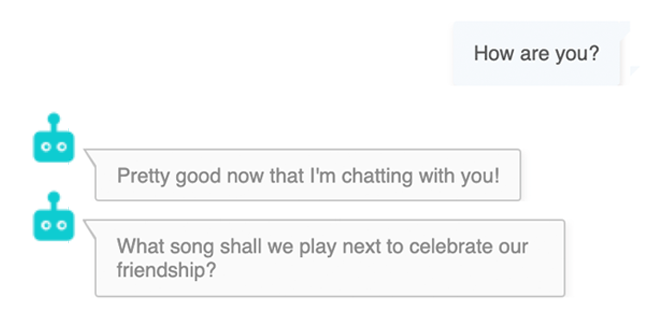Helpful, engaging, successful and even funny? No, that’s not too much to ask of a chatbot! And it gets even better. If you go about it the right way, it’s actually really easy, too! We show you how to design the perfect chatbot for your company — in just seven steps.
Chatbots don’t have it easy. In fact, people judge them… A LOT. They've been called boring, bad listeners, awkward conversationalists, and, worst of all, useless. To be fair, there are a lot of terrible chatbots out there. However, that’s not their fault because bots are designed by people. So, we have to stop to put all the blame on the bots, and start looking at better ways to design chatbots to make them helpful, engaging, and fun. The good news is: that’s a lot easier than you might think.
You don’t need a specialized IT department to implement a good chatbot for your company, but you do need to put some thought into creating a bot. In our guide, we'll show you how to design the perfect chatbot for your company — in just seven steps.
1. Decide on the purpose of your chatbot
Before you start designing a chatbot, you first have to define why you want to use a bot. Do you have a service that you want to automate, such as making appointments? Or, do you want to use a bot for marketing purposes, and engage more with your customers?
Once you define a goal for the bot, make sure that you also clarify how a bot will help you get there. What is the process in your company now, and where will it be ideally with the help of the bot? This allows you to narrow down the exact role of the bot. Be as clear and as specific as possible because the purpose of the chatbot will be the foundation of everything you create around it.
2. Create concrete use cases for your bot
It’s not enough to define a goal for your bot, you also have to know what your bot will be doing exactly to reach this goal. In other words, what are the tasks that should be completed by your bot? Should it:
- send directions to users?
- update customers on flight information?
- help customers reserve a table at a restaurant?
- send shopping suggestions?
- answer FAQs in customer service?
When first starting out, keep it simple, and make sure everything goes smoothly. You can always build on the foundation you have later. If you're just building your first bot, ready-to-go solutions such as Sinch Engage can be a great start. Here, you can use a drag-and-drop chatbot builder or templates, and design your first chatbot in a few minutes.
3. Choose the channels of interaction
Once you have defined the goals for your bot and the specific use cases, as a third step, choose the channels where your bot will be interacting with your customers.
Are you planning to use the bot on your website, integrate it in your app, use GPT integrations, add it to a messenger app, — or all of the above? Do you want to use GPT integraionsKeep in mind that each channel is different, with varying technical parameters and different ways of interaction. You want to make sure that the chatbot you design works well on the channel (or channels) you pick.
Get started with your multi-channel bot now!
4. Define your customers
When designing a chatbot, companies sometimes put a lot of thought into the technology, but forget about their customers. That’s a huge mistake! After all, your bot will be interacting with your customers, so it’s important to know who they are. In order to get an idea of who your chatbot will be talking to, answer the following questions:
- What is your customers’ backstory?
- Why are they contacting you?
- What do they expect from your company?
- What don’t they like about chatbots (and how can you counteract that)?
Of course, no two people are alike, but the better you understand the needs of your customers, the better the flow of the human-bot-conversation will be.
5. Give your bot a personality
A lot of companies stop after step four when designing a chatbot. They think that once they know what the chatbot is supposed to do and why, they're all set. However, what many people forget is that bots should have a personality, too. After all, they'll interact with humans. As Tess Tettelin, Conversation Design Lead at Sinch, puts it:
"A chatbot without personality is like a bad Tinder date: they look great online, but as soon as you start talking to them, you want to end the date as soon as possible."
When breathing life into your chatbot, make sure that your bot’s personality matches your brand and your customers. If your brand is quirky and your customers are young and hip, your chatbot’s personality should reflect that. When choosing your bot’s personality, it can help to answer a few key questions first:
- What's the backstory of your bot?
- What is your bot’s life purpose?
- Where are the biggest weaknesses and the biggest talents?
- What’s your bot’s alter ego?
The more you think of your bot like an actual person, the more engaging its personality will be for your customers.
Important! Chatbots should have emotions! After all, emotions drive human decisions. If your clients feel connected to your bot, they'll have a better experience, be easier convinced, and also be more forgiving and patient if your bot makes a mistake.
💡How BMW automated 80% of their customer interactions with a chatbot
6. Create a happy flow of conversation
Once you've followed the previous steps, designing dialogs for your chatbots actually becomes a lot easier because you already know what you want to achieve with the bot, and how it should talk to your customers. So, now it’s time to think about the essential pillars of the dialog.
- Introduction: How will the bot introduce itself? Don’t be afraid to let its personality shine here!
- Information: How will the bot ask for and confirm information?
Tip: you don’t want to entertain your customers at this point, just give quick information. Go for functionality over personality here!
- Invalid responses: How will your bot handle questions it won’t understand?
Sometimes, companies prefer to think that their chatbots won’t make mistakes, but there will certainly be scenarios of miscommunication, just like in human conversations. Be prepared, and teach your bot how to handle them. This could also be a great opportunity for inducing humor into the conversation.

- Non-verbal communication
Even with text-based chatbots, there will be moments where the bot won’t communicate, for instance, because the bot is trying to access a user’s data. Make sure that the customer knows what is going on during these silent moments, and doesn’t feel left alone. For example, the bot could say something like: “Let me check your information. I'll be right back.”
- Fulfillment messages
If the bot was able to solve a customer’s issue: celebrate it together! It will enhance the user experience with the bot, and leave your customers with a feeling of accomplishment.
7. Test, measure, and improve
At this point, you have designed a fun, engaging and helpful bot for your business and for your clients. Now, it’s time to put it to the test. Run smaller beta tests first, so you get a chance to fix mistakes and improve the bot before you roll it out for all of your customers.
Once you have implemented your chatbot, keep collecting data, and analyze its performance. First, define metrics for measuring success, such as fulfilled conversations, or time spent per customer query. Then, check how your bot is doing.
Is the bot really helping you to meet your KPIs? Are your customers really satisfied with the interaction? Are your employees benefitting from the bot? What can you do to improve the performance?
Just like humans, bots aren’t perfect, and there is always room for growth. If you follow these steps though, you will definitely end up with a great chatbot for your company that will help your business and that your customers will love!
Ready to try it out for yourself? On Sinch Engage, you can build your first chatbot in minutes (no IT skills needed)!




